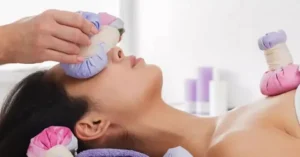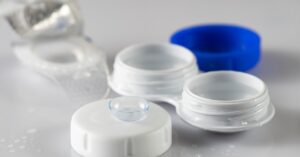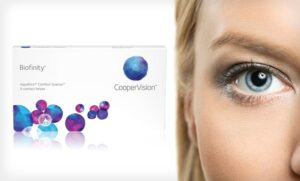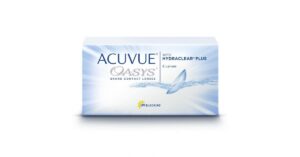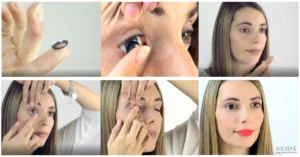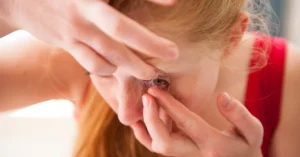Understanding Dry Eye Syndrome and Contact Lenses
For contact lens wearers, dealing with dry eye syndrome can be a challenging experience. Dry eye syndrome refers to a condition in which the eyes do not produce enough tears or the tears evaporate too quickly, leading to discomfort and irritation. When combined with contact lenses, dry eye symptoms can become even more pronounced, making it essential to understand the relationship between dry eyes and contact lenses.
What is Dry Eye Syndrome?
Dry eye syndrome is a common condition that affects millions of people worldwide. It occurs when the eyes are unable to maintain proper lubrication, resulting in dryness, itchiness, redness, and a gritty sensation. This condition can be caused by various factors, including age, environmental factors, certain medications, and underlying health conditions.
Challenges of Wearing Contact Lenses with Dry Eyes
Individuals who wear contact lenses and also suffer from dry eye syndrome may face additional challenges. The presence of contact lenses on the surface of the eyes can disrupt the natural tear film, leading to increased evaporation and further exacerbation of dry eye symptoms. The discomfort experienced can range from mild irritation to severe pain, making it difficult to wear contact lenses for extended periods.
Contact lens wearers with dry eyes may also experience other issues such as contact lens dryness, irritation, and intolerance. These issues can impact the overall wearing experience and may require adjustments to contact lens type, care routine, and lifestyle choices.
The Importance of Addressing Dry Eye Symptoms
Addressing dry eye symptoms is crucial for contact lens wearers to ensure comfort and maintain good eye health. Ignoring dry eye symptoms can lead to further irritation, corneal damage, and an increased risk of complications. By taking proactive steps to manage dry eyes, contact lens wearers can continue to enjoy the benefits of wearing contact lenses while minimizing discomfort and potential complications.
In the subsequent sections, we will discuss various strategies for managing dry eye symptoms and maximizing comfort while wearing contact lenses. This includes the use of lubricating eye drops for dry eyes, maintaining proper contact lens hygiene, considering nutritional adjustments, and exploring lifestyle modifications. By implementing these practices, contact lens wearers can navigate the challenges posed by dry eye syndrome and enjoy a comfortable and rewarding contact lens experience.
Dry Eye Treatments
When it comes to dealing with dry eye symptoms while wearing contact lenses, several strategies can help alleviate discomfort and maintain optimal eye health. By incorporating lubricating eye drops, practicing proper contact lens hygiene, and considering nutritional factors, contact lens wearers can treat dry eyes more effectively.
Lubricating Eye Drops for Dry Eyes
Lubricating eye drops, also known as artificial tears, are a common solution for relieving dry eye symptoms. These drops can help replenish the moisture in the eyes, providing temporary relief from dryness, irritation, and discomfort. It’s important to choose eye drops specifically formulated for dry eyes and compatible with contact lens wear. Look for preservative-free options to minimize the risk of irritation. For more information on dealing with dry eyes, refer to our article on dry eye syndrome and contact lenses.
Proper Contact Lens Hygiene
Maintaining good contact lens hygiene is crucial for individuals with dry eyes. Following these hygiene practices can help reduce the risk of eye irritation and infection:
- Cleanliness: Always wash your hands thoroughly with soap and water before handling your contact lenses. This helps prevent the transfer of dirt, oils, and bacteria onto the lenses.
- Proper Disinfection: Clean and disinfect your contact lenses as recommended by your eye care professional. Use the appropriate lens solution and follow the instructions carefully to ensure effective disinfection.
- Replace on Schedule: Replace your contact lenses according to the recommended schedule. Overwearing or using expired lenses can contribute to dryness and discomfort.
- Avoid Water: Never rinse your contact lenses with tap water or expose them to water sources like swimming pools or hot tubs. Water can introduce harmful microorganisms to your eyes, leading to infections.
By adhering to these hygiene practices, you can minimize the risk of contact lens-related dryness and irritation. If you’re experiencing persistent dryness or discomfort, consult your eye care professional for further guidance. For more information on contact lens-related issues, refer to our articles on contact lens dryness, contact lens irritation, contact lens intolerance, and contact lens problems.
Nutritional Considerations for Dry Eyes
Incorporating certain nutrients into your diet can potentially improve dry eye symptoms. These include:
- Omega-3 Fatty Acids: Found in fatty fish like salmon, sardines, and mackerel, as well as flaxseeds, chia seeds, and walnuts, omega-3 fatty acids have been shown to help reduce inflammation and support eye health.
- Vitamin A: Foods rich in vitamin A, such as carrots, sweet potatoes, spinach, and kale, can contribute to better eye lubrication and tear production.
- Vitamin C: Citrus fruits, bell peppers, strawberries, and broccoli are excellent sources of vitamin C, which plays a role in maintaining healthy tear production.
- Hydration: Staying hydrated is essential for overall eye health. Drink an adequate amount of water throughout the day to prevent dehydration, which can exacerbate dry eye symptoms.
While proper nutrition can support eye health, it’s important to note that dietary changes alone may not completely alleviate dry eye symptoms. Consult with your eye care professional for personalized recommendations and guidance specific to your situation.
By incorporating these strategies into your routine, you can effectively manage dry eye symptoms while wearing contact lenses. Remember to consult with your eye care professional for personalized advice and guidance on long-term strategies for managing dry eyes and contact lenses.
Tips for Comfortable Contact Lens Wear with Dry Eyes
Finding comfort while wearing contact lenses with dry eyes can be challenging, but with the right strategies, it is possible to enjoy clear vision without discomfort. Here are some tips that can help make your contact lens-wearing experience more comfortable:
Choosing the Right Contact Lenses
When you have dry eyes, it’s important to choose contact lenses that are specifically designed for individuals with this condition. Look for lenses that offer high moisture retention and are labeled as “moist” or “hydrogel.” These lenses are designed to retain moisture on the surface, reducing the chances of dryness and irritation.
Another consideration is the material of the contact lenses. Silicone hydrogel lenses tend to be more breathable and allow for better oxygen flow to the cornea, which can help minimize dryness and discomfort. Consult with your eye care professional to determine which type of contact lenses will work best for your specific needs.
| Contact Lens Type | Features |
|---|---|
| Moist or Hydrogel Lenses | High moisture retention |
| Silicone Hydrogel Lenses | Improved breathability |
Contact Lens Care and Cleaning
Proper contact lens care and cleaning are crucial for maintaining comfort and preventing dryness. Always follow the recommended cleaning routine provided by your eye care professional or the lens manufacturer. It’s essential to keep your lenses clean and free from debris or deposits that can exacerbate dryness and irritation.
Additionally, use preservative-free lubricating eye drops recommended for contact lens wearers to provide extra moisture throughout the day. These drops can help alleviate dryness and provide relief from discomfort. For more information on lubricating eye drops, check out our article on contact lens dryness.
Lifestyle Adjustments for Dry Eye Relief
Making certain lifestyle adjustments can also contribute to relief from dry eyes while wearing contact lenses. Here are some tips to consider:
- Stay hydrated: Drinking an adequate amount of water can help maintain overall hydration, including your eyes.
- Avoid smoke and dry environments: Smoke and dry air can further irritate dry eyes. Try to minimize exposure to these conditions when possible.
- Take regular breaks: If you spend a significant amount of time in front of screens or in dry environments, take regular breaks to rest your eyes and blink more frequently.
By implementing these tips, you can enhance your comfort while wearing contact lenses, even with dry eyes. However, it’s important to remember that every individual’s experience may vary. If you continue to experience discomfort or dryness, it’s advisable to consult an eye care professional for further guidance. They can provide additional recommendations and discuss potential treatment options to manage both dry eye syndrome and contact lenses. For more information on common contact lens problems and solutions, check out our article on contact lens problems.
Seeking Professional Assistance
For individuals experiencing dry eye syndrome and struggling with wearing contact lenses, seeking professional assistance is essential. Consulting an eye care professional can provide valuable guidance and expertise in managing both dry eyes and contact lenses. They can assess your specific situation and recommend appropriate solutions to alleviate discomfort and preserve eye health.
Consulting an Eye Care Professional
When dealing with dry eyes and contact lenses, it is crucial to consult an eye care professional. They have the knowledge and expertise to evaluate your condition and provide tailored recommendations. During a contact lens exam, the eye care professional will assess your symptoms, examine your eyes, and review your contact lens usage. They may ask about your lifestyle, habits, and any medications you are taking to better understand the root causes of your dry eye symptoms.
Based on their evaluation, the eye care professional can suggest personalized strategies to manage dry eyes while wearing contact lenses. This may include adjustments to your contact lens type, lens care routine, and lifestyle factors that impact dry eye symptoms. Regular follow-up appointments with the eye care professional can help monitor your progress and make necessary modifications to your management plan.
Treatment Options for Dry Eye Syndrome
Eye care professionals can recommend various treatment options to alleviate dry eye symptoms and improve comfort while wearing contact lenses. These treatment options may include:
- Artificial tears and lubricating eye drops: These over-the-counter or prescription eye drops can provide temporary relief by lubricating the eyes and reducing dryness. Different types of lubricating eye drops are available, so the eye care professional can guide you in selecting the most suitable option for your specific needs.
- Prescription medications: In some cases, the eye care professional may prescribe medications to manage underlying causes of dry eye syndrome, such as inflammation or inadequate tear production. These medications can help alleviate symptoms and improve overall eye health.
- Punctal plugs: Punctal plugs are tiny devices inserted into the tear ducts to block the drainage of tears, thus keeping the eyes more lubricated. This can be an effective option for individuals with chronic dry eye.
Long-Term Strategies for Managing Dry Eyes and Contact Lenses
In addition to specific treatment options, eye care professionals can provide long-term strategies for managing dry eyes and wearing contact lenses comfortably. These strategies may include:
- Proper contact lens selection: The eye care professional can help you choose contact lenses that are more suitable for individuals with dry eyes. This may involve recommending specific lens materials or designs that promote better hydration and comfort.
- Education on contact lens care: Proper contact lens care and hygiene are crucial for individuals with dry eyes. The eye care professional can guide cleaning routines, lens replacement schedules, and the use of contact lens solutions to minimize contact lens-related dryness and irritation.
- Lifestyle adjustments: The eye care professional may suggest lifestyle changes or modifications that can contribute to better eye health and alleviate dry eye symptoms. These adjustments may include factors such as maintaining good hydration, avoiding environments with excessive dryness or irritants, and following a healthy diet rich in omega-3 fatty acids.
By consulting an eye care professional, individuals experiencing dry eyes while wearing contact lenses can receive expert guidance and appropriate treatment options. With their help, it’s possible to find effective solutions that allow for comfortable and enjoyable contact lens wear while managing dry eye symptoms. Remember, proper eye care and seeking professional assistance are essential for maintaining healthy eyes and optimal vision.






